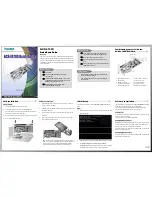
Document Title Here
AET65 API
Version 1.0
idvation GmbH
Otto-Hesse-Straße 19 / T5
Phone +49 6151 9926567
D-64293 Darmstadt
Fax +49 6151 3689296
www.idvation.com
Page 74 of 84
Page 74 of 84
ABS_PARAM_IFACE_VERSION 13
Read-only global parameter which determines version of BSAPI interface.
Value is represented as ABS_DATA with 1 byte of length. This version of BSAPI uses version 2 of the
interface.
Note that corresponding versions of BSAPI.DLL always get the same value of this parameter.
ABS_PARAM_POWER_SAVE_CHECK_KEYBOARD 14
This global parameter determines if keyboard and mouse are treated as a user activity.
Value is represented as ABS_DATA with 4 bytes of length. Zero means the keyboard and mouse
actions are not treated as a user activity, so only touching the sensor has impact to power
management. Non-zero means the keyboard and mouse are considered a user activity.
On Windows, the default value is 1 unless BSAPI is running in NT service compatible mode i.e.
unless it is initialized with function ABSInitializeEx with flag ABS_INIT_FLAG_NT_SERVICE set. If
BSAPI is in NT service compatible mode, the default value is zero.
Note that on Windows and when the parameter is set to 1, the user activity is detected only in a
context of active user's session. If the process does not run in active user's session, user actions on
keyboard and mouse are not detected.
On other systems, default value is zero and setting the value is not supported.
See also ABS_PARAM_POWER_SAVE_MODE and ABS_PARAM_POWER_SAVE_TIMEOUT.
ABS_PARAM_LATENT_CHECK 16
This global parameter determines whether anti-latent checks are performed implicitly.
Value is represented as ABS_DATA with 1 byte of length. If set to 0, the anti-latent checks are
disabled, when 1 (default) the checks are enabled, so any call to ABSEnroll or ABSVerify implicitly
checks for latent fingerprints on area sensors.
After calling another functions (e.g. ABSGrab or ABSCapture), it's up on application to do the check
manually with function ABSCheckLatent if it desires to do so.
See chapter 3.1.5 for more information about anti-latent technology.











































